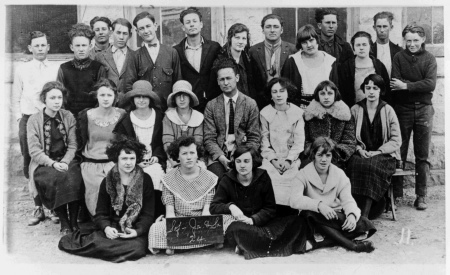Timeline: LBJ and the Nation
1908-1919 1920-1929 1929-1940 1941-1945 1946-1953 1954-1960 1960-1963 1963-1969 1969-1973
1920-1929
The disillusionment that followed the war turned the nation’s attention inward, to a decade of prosperity and social upheaval, as old conventions gave way to an exhilarating array of liberated ideas. The automobile, produced in abundance, brought a new sense of freedom, heightened by a relaxation of moral standards; that new-found freedom was reflected and celebrated in changing styles and customs and manners.
American writers found a new authentic American voice to record it all. Music found a new idiom in jazz and the wail of a saxophone. The heroes of the day were boxers and ballplayers and the glittering stars of the fast-growing phenomenon of the cinema. Greatest of them all was a pioneer aviator named Charles Lindbergh, who in making the first nonstop flight between New York and Paris symbolized in his solitary voyage the gallant spirit of a restless and daring time.
In the 1924 graduating class photograph, the boy who will become the high school's most prominent alumnus is fifth from the left, top row. Lady Bird traveled eighteen miles a day to go to highschool, where she was an outstanding student and graduated at age fifteen. She is sitting sixth from the left, middle row.
Events
- Although Wilson was not a candidate for re-election in 1920, his proposal that the U.S. enter the League of Nations was rejected when the voters elected Republican Warren G. Harding, who promised a "return to normalcy." Harding died in office and was succeeded by Calvin Coolidge, who presided over most of the decade of abundance. Herbert Hoover, who had directed a program to feed impoverished post-war Europe, was elected president in 1928.
- George Herman ("Babe") Ruth, the New York Yankees' "Sultan of Swat," captivated the American public with his cocky bravado and unmatched ability on the diamond, where he hit 60 home runs in a single season and 714 during his career, records that stood for thirty-four and thirty-nine years.
- Ernest Hemingway, writing about his generation in a crisp, muscular style, was one of the brilliant new novelists ushering in a bountiful period of American literature which also saw the emergence of such writers as F. Scott Fitzgerald, Sinclair Lewis, Sherwood Anderson, and William Faulkner.
- Paul Whiteman organized his first dance orchestra in 1918. His band, featuring musical greats such as Bix Beiderbecke, the Dorsey Brothers, Henry Busse, and Bing Crosby, became the sound of the decade.
- The Ku Klux Klan provided an uglier look at the era. Formed in the Reconstruction period after the Civil War, it was revived in the 1920s as an organization hostile to blacks, Jews, Catholics, and foreigners. When it made its white-robed march through Washington in 1925, it claimed more than four million members.
Lyndon Baines Johnson
The boy, who would become the school's most prominent alumnus, graduated from Johnson High School in 1924. "He led the normal, uneventful but enjoyable life of a popular, fun-loving teenager," his mother wrote of him. Contemporaries remembered him as one who needed to exert leadership.
Lady Bird Johnson
Lady Bird had to travel eighteen miles from Karnack to go to high school in Marshall. She was an outstanding student and graduated at age fifteen.

